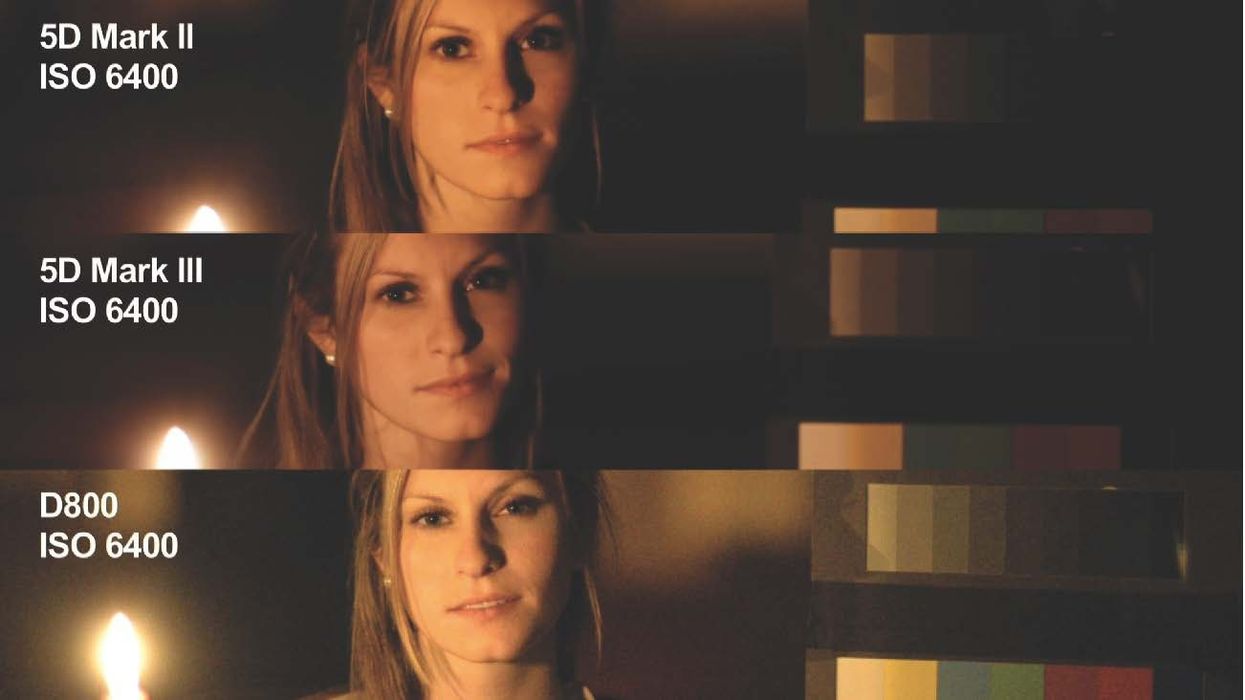5D Mark III/D800 Hands-On Part 4: Mark II vs. Mark III vs. D800 - Candlelight

Well it's taking a bit longer to get these up than I'd hoped, but I think the evidence in this one is the most obvious of any test I've seen so far. This time the Canon 5D Mark II has been thrown into the mix, in addition to the 5D Mark III and the Nikon D800. We were in a room with large windows well into the night, and so there are a couple streetlights providing very basic illumination at the higher ISOs. Other than that the only light is the candle right in front of our model Sasha.
ISO 500 was chosen as the starting off point because it was the first ISO that really started to produce an image with the candle. Here are the settings for the video, this time the Nikon was recorded to ProRes 4:2:2 HQ from an Aja KiPro and the Mark III was recorded ALL-I internally:
- ISO 500-25,600
- Nikon 85mm f/1.4 lens
- Default/Neutral Color Profiles
- Canon ALL-I & Nikon KiPro ProRes 4:2:2 HQ
- Noise Reduction Off
- WB: 3200K
- Shutter 50
- F-stop stayed the same throughout - F/1.4
And the video (again be sure to download the 1080p file for better compression):
As you can see, the D800 is still significantly brighter at lower ISOs, and still a bit brighter at higher ISOs - this has not changed and the same exact lens was used on all three cameras. I'm actually going to try to figure out what ISOs these cameras should really be reporting based on some light meter readings in the next day or so. The results speak for themselves - the Nikon D800 is sharp, but very noisy. It's a camera that needs a lot of light, but when you give it that light, it has a beautiful picture coming out of the HDMI.
The 5D Mark II still holds up very well, but there is a noticeable shift to green at higher ISOs which has always been the case for that camera. The Mark III and the D800 do not have a shift in that way. I think some of the noise of both Canon cameras is being hidden by compression. With the Nikon going straight to ProRes, it's got the cleanest image, and thus the noise is going to be much more noticeable - but also easier to get rid of in post.
The Mark II is obviously a bit noisier than the Mark III, two stops or so (just like Canon said). It's still usable because its noise isn't too noticeable out of the box until around 2500-3200 - mostly helped by compression. The Nikon is just a big mess by 6400, and it would take heavy noise reduction to bring it back. I still don't care what people say about film-like grain, noise is still noise, and if it's not part of your aesthetic, it's going to stick out unless you get rid of it. The Mark III is very, very clean. I would have no problem shooting at 6400 ISO with the Mark III and using it in a professional piece. There's a little bit of noise, but it is mighty impressive. Not only that, but the Mark III holds skin tones quite a little bit better than the Mark II at 6400. The D800 is a bit yellowish in the skin tones, not quite as pleasing, but nothing a little color correction can't fix at 4:2:2 color sampling. None of the cameras were corrected for the candle, they were simply left at Tungsten to keep it consistent.
So we've got a couple more parts in this series left, but the D800 is definitely hurt by its high megapixel count in low-light. The D800 is a camera that should be left at 640-1000 (which is comparable to 1250 and 2000 on Canon) for the most part and lighting used to compensate. It's much less of a run and gun camera than the Mark III, which can shoot in almost any light, thanks to its improved light gathering ability. Nikon didn't know what Canon was going to release when the Mark III was announced, but you can bet what they will be working on in their next version: aliasing. Aliasing is pretty bad, but we'll get to that soon enough.
Another big benefit for using the HDMI on the Nikon, there's a lot more color separation in the light from the candle. The Mark II has some heavy banding and the Mark III is a bit better thanks to the ALL-I, but the D800 really shines because of the massive amount of information contained in the 8-bit 4:2:2 HDMI.
I wouldn't count out either camera yet - they are both fantastic performers, and it's getting to a point where you really need the right camera for the job at this price point. Need the uncompressed HDMI and the resolution: Nikon (unless we all want to modify the Mark III). Need the low-light: Canon.
Anyone think the Nikon noise is pleasant? (I have a tough time deciding.)
Links: All Parts
Part 1: 5D Mark III/D800 Hands-On: Initial Impressions (Mark III)
Part 2: 5D Mark III/D800 Hands-On: Initial Impressions (D800)
Part 3: 5D Mark III/D800 Hands-On: ISO Range Test













